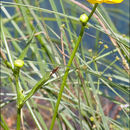Associations
provided by BioImages, the virtual fieldguide, UK
Foodplant / open feeder
adult of Donacia aquatica grazes on windowed leaf (upper surface) of Ranunculus lingua
Remarks: season: 5-7(-10)
In Great Britain and/or Ireland:
Foodplant / parasite
Erysiphe aquilegiae var. ranunculi parasitises Ranunculus lingua
Foodplant / miner
larva of Phytomyza ranunculi mines leaf of Ranunculus lingua
Foodplant / spot causer
hypophyllous, in small groups aecium of Puccinia magnusiana causes spots on live leaf of Ranunculus lingua
Foodplant / spot causer
amphigenous, but mainly epiphyllous colony of Ramularia anamorph of Ramularia didyma var. didyma causes spots on live leaf of Ranunculus lingua
Description
provided by eFloras
Herbs perennial. Stems ca. 75 cm, to 10 mm thick, strigose, few branched above, rooting near base. Basal leaf withering at anthesis. Lower stem leaves with petiole short, ca. 1.5 cm; blade linear-lanceolate, 10--15 × 0.7--2 cm, papery, appressed puberulent, base attenuate or rounded, margin entire, sparsely glandular. Upper stem leaves sessile. Compound monochasium terminal, corymbose, 3- or 4-flowered; bracts leaflike. Flowers 2.7--3.8 cm in diam. Pedicel 2--13.5 cm. Receptacle glabrous. Sepals 5, elliptic-ovate, ca. 7 mm, abaxially appressed puberulent. Petals 5, flabellate-obovate, 17--20 × 14--17 mm, nectary pit without a scale, apex truncate, often emarginate. Stamens numerous; anthers oblong. Aggregate fruit broadly ovoid, ca. 9 mm in diam. Achene obliquely obovoid, 2--3 × 1.5--1.8 mm, glabrous; style persistent, very short.
- license
- cc-by-nc-sa-3.0
- copyright
- Missouri Botanical Garden, 4344 Shaw Boulevard, St. Louis, MO, 63110 USA
Habitat & Distribution
provided by eFloras
C Xinjiang [Kazakhstan, Russia (Siberia); Europe].
- license
- cc-by-nc-sa-3.0
- copyright
- Missouri Botanical Garden, 4344 Shaw Boulevard, St. Louis, MO, 63110 USA
Ranunculus lingua: Brief Summary
provided by wikipedia EN
Ranunculus lingua, the greater spearwort, great spearwort, tongue-leaved crowfoot, or water buttercup, is a plant species in the family Ranunculaceae native to temperate areas of Europe, Siberia and through to the western Himalayas. It is a semiaquatic plant that prefers to grow in about 40 cm (16 in) of water in a variety of wetland habitats. A cultivar (or perhaps a traditional variety) called 'Grandiflorus', the large-flowered greater spearwort, has 6 cm flowers and is favored by gardeners.

In a garden setting
- license
- cc-by-sa-3.0
- copyright
- Wikipedia authors and editors


 In a garden setting
In a garden setting